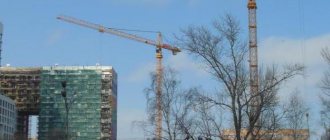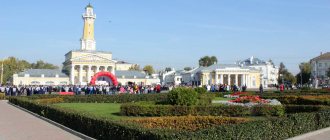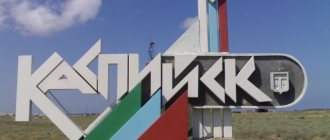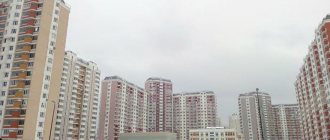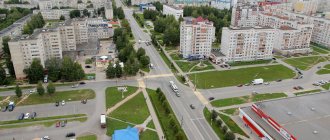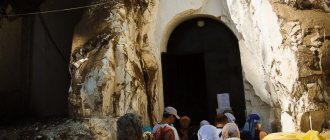Podolsk is the administrative center of the urban district of the same name (the only populated area within it), one of the largest satellites of Moscow. The city is located 15 km from the Moscow Ring Road and only 36 km from the center of the capital. On the territory of the settlement there are about 2 dozen industrial enterprises, which provide jobs to a significant part of the local population and are the basis of the city’s economy.
The population is about 310 thousand people, it has had city status since 1781. Currently, there is a developing trend towards Moscow gradually absorbing the near Moscow region and merging settlements into a single metropolis. Can today’s Podolsk be considered part of the capital or is it too early? Let’s look at it in this article.
The first settlements on the Pakhra River (a tributary of the Moscow River) arose in ancient times (settlement by the Slavs dates back to approximately the 10th century). In the 14th century, these territories were already part of the Moscow Principality; the river served as a reliable water route between local villages and the capital, the main one among which was the village of Podol.
Podolsk received city status by decree of Catherine II, at the end of the 18th century.
During Soviet times, especially starting from the 1930s, the city experienced rapid industrial growth.
Today the settlement is one of the developed industrial centers of the Moscow Region. The consumer sector is well developed, the city has the same shops, cafes, salons and representative offices of large retail chains as in the capital, there is a ski resort and cultural and leisure centers. Podolsk is actively being developed with new square meters of living space, including as part of the implementation of state projects. programs for the resettlement of dilapidated housing. The cost per square meter still remains below Moscow.
Social infrastructure
The status of a large, industrially developed city near Moscow implies progressive dynamics of population growth and the need for objects of social significance. On the territory of Podolsk the following applies:
- 4 city hospitals and 5 clinics, private medical centers, ambulance stations and a number of state-owned. honey. MO institutions;
- Ministry of Defense Hospital;
- about 30 schools and five dozen kindergartens;
- 8 universities.
Thus, the city has a complete, self-sufficient system of social security for the population, independent of the capital’s institutions.
Transport and communication with Moscow
Internal transport links in the city are based on buses and trolleybuses, and there are minibuses.
Podolsk is located near the federal highway M-2 (“Crimea”), along which the capital can be reached either by private car or by bus or minibus. The nearest metro station is “Lesoparkovaya”, most of the public transport goes to it (exception No. 407, which can be used to get to the stations “Anino” and “Dmitry Donskoy Boulevard”).
Other ways to get to Moscow:
- by train from the Podolsk railway station (full-fledged, stone) and two additional platforms: “Silikatnaya” and “Kutuzovskaya”. Traffic is carried out along the Moscow-Kharkov railway line;
- MCD-2 (Moscow Central Diameters), is a ground-based analogue of the metro, opened in November 2021, connects Podolsk with Nakhabino, passing through the entire capital. The frequency of electric trains here is approximately 12 minutes, there are no traffic jams, and there is the possibility of a free transfer to the “classic” metro.
The implementation of the MCD project has significantly simplified the connection between Podolsk and the capital, bringing both cities even closer together.
Links[edit]
Notes[edit]
- ^ abcdef Law No. 11/2013-OZ
- ^ abcdef Law No. 65/2005-OZ
- ^ a b Federal State Statistics Service (2011). “All-Russian Population Census 2010. Volume 1" [All-Russian Population Census 2010, vol. 1]. All-Russian Population Census 2010 [All-Russian Population Census 2010]
. Federal State Statistics Service. - Resolution No. 123-PG
- Urban-type settlements may include workers' settlements, resort settlements, holiday villages, as well as urban-type settlements themselves.
- ↑
Federal State Statistics Service of Russia (May 21, 2004).
“The population of Russia, the constituent entities of the Russian Federation as part of federal districts, urban settlements, settlements, settlements is 3 thousand or more people” [Population of Russia, its federal districts, federal districts, districts Urban settlements, rural settlements - administrative centers and rural settlements with a population of over 3,000] (XLS). All-Russian Population Census 2002
. - “All-Union Population Census of 1989. The current population of union and autonomous republics, autonomous regions and districts, territories, negative phenomena, urban settlements and rural district centers” [All-Union Population Census of 1989: current population of union and autonomous republics, Autonomous regions and districts , territories, regions, districts, urban settlements and villages performing the functions of district administrative centers. All-Union Population Census of 1989 [All-Union Population Census of 1989]
.
Institute of Demography of the National Research University: Higher School of Economics [Institute of Demography of the National Research University: Higher School of Economics]. 1989 - via Demoscope Weekly
. - Official website of the Moscow Government. Draft capital measures taken and regional authorities regarding the expansion of Moscow borders (in Russian)
- Law No. 145/2004-OZ
Future prospects
In the future, there will be oncoming residential development in the direction from Moscow to Podolsk. In addition, the economy of the satellite city is closely connected with the capital city; a significant part of the products is intended either for the capital or goes to the regions through its logistics hubs.
The MCD lines are a project connecting Moscow with the territories of the Moscow Region into a single structure. Further development in this direction, coupled with the development of the Moscow region with new residential areas (which is caused by a shortage of free land in the capital) will lead to the emergence of a huge metropolis on the site of today’s independent administrative units.
The standard of living in today's Podolsk is not much different from Moscow. The city has enough paid jobs and getting to the capital has become even easier after the launch of the Podolsk-Nakhabino ground metro line. At the same time, the settlement is well developed and self-sufficient, and has all the necessary social and infrastructure facilities on its own territory. The economic prerequisites are all met, but there is currently no need for a formal unification of Podolsk with Moscow. In the future, this may happen as a result of the convergence of residential areas.
Zalineiny district. Part I
This part of Podolsk got its name because of its location - since 1869 it has been separated from the city center by the line of the Moscow-Kursk Railway. This is one of the darkest and, at the same time, most interesting areas of the city. Enterprises and industrial zone
Near the Podolsk station Until the beginning of the twentieth century, the area behind the railway was practically not developed. Only in 1915, during the First World War, the construction of a large cable plant of the Moscow Association of Copper Rolling and Cable Plants began here. They never had time to complete the construction due to the events of 1917. In 1919-20, during the Civil War, an enterprise for the repair of steam locomotives was created on its basis, which was strategically important for the Bolsheviks. The first locomotive left the overhaul on September 2, 1920. In 1930 it was once again repurposed. It began to be called cracking-electric locomotive-building (CES) and produced oil equipment and electric locomotives for mines. In addition, he also produced tubes for the Moscow metro. On April 8, 1936, the plant was named after the People's Commissar of Heavy Engineering Sergo Ordzhonikidze. In the 1930s, near the entrance overlooking Zheleznodorozhnaya Street, a sculpture of him was installed, dressed in a characteristic long overcoat.
Monument to Ordzhonikidze Around the plant in the 1910-30s, two large villages were formed - Northern and Southern.
Twin water towers on Bronnitskaya Street In the 1920s-60s, others appeared in the Zalineinnaya part of the city, a battery tower, etc. They formed a vast industrial zone. Judging by my observations, there are quite a lot of interesting structures in it (according to fairplay , the battery plant even has a water tower designed by Shukhov). Alas, I have not yet been able to get into the factories and inspect them in detail.
Block building in an industrial zone. Obviously, the construction was from the 1920s. For now, I’ll move on to the story about the sights of the residential areas of the Zalineiny district. Basically, we will talk about the villages of North and South. The first of them contains the most interesting buildings of the 1910-30s, the second contains colorful buildings of the 1940-50s. Severny Village Severny Village, as its name correctly indicates, is located on the north side of the Ordzhonikidze Plant. Here are the plans for two of its districts with the most valuable development:
Most constructivist buildings from the late 1920s are labeled as 1930s to avoid confusion with houses from 1923. 1910s The oldest buildings in Severny were obviously built just before the revolution and can be classified as examples of late modernism. This is a two-story house with neoclassical features (Orzhonikidze, 4) and symmetrically located workers' barracks (Orzhonikidze, 11 and 13).
Ordzhonikidze, 13. Right building 1915
Ordzhonikidze, 11. Left building 1915 Nowadays, the workers' barracks (Ordzhonikidze, 11 and 13) still house factory dormitories. If it were not for the bright red-yellow color of the walls (this is a traditional color scheme for Podolsk), these buildings would be very modest. The only striking detail that allows us to classify them as modern is
A giant flowerpot in summer A small square in front of the barracks is decorated with a giant multi-colored Stalinist flowerpot () and
Mira, 6. The front facade facing the courtyard has many features of pre-revolutionary architecture.
Mira, 6. The rear facade is much more similar to its counterparts of the 1920s. Another building (Mira, 6) should be classified as a transitional type - it has features of both pre-revolutionary and Soviet architecture. By analogy with the famous houses on Chkalova Street in Krasnoarmeysk near Moscow, I would also date it to the mid-1920s. 1923
House from 1923. The courtyard facade, also known as the main façade. The oldest Soviet buildings (at least those that are dated) in this quarter were erected in 1923. Let me remind you that in this year the construction of stone housing in the USSR was extremely rare. Here we see not just a separate house, but a small ensemble formed near the pre-revolutionary workers' barracks. These are houses 8 and 10 on the current Mira Street (it would be interesting to know what it was called in the 1920s).
House from 1923. Rear view, from the small street Mira Rubezh 1920-30s The second wave of buildings in Severny appeared already in the late 1920s - early 1930s. The houses built near the western factory entrance on Zheleznodorozhnaya Street (No. 14) and in the Northern Dead End (No. 3, No. 5) have a strict and gloomy appearance, traditional for the constructivist architecture of the Moscow region near the factory.
Zheleznodorozhnaya, 14. Gloomy house with a grocery store
In the Northern Dead End Adjacent to the workers' barracks quarter, the constructivist buildings on Ordzhonikidze (No. 9) and Severnaya (No. 1 and No. 2) streets are more festive. If house No. 1 is a striped three-story building common for those years, then houses No. 9 and No. 2 are very harmonious and interesting examples of constructivism.
Ordzhonikidze, No. 9. Constructivist house from the late 1920s. This is a fairly rare type of house, but not unique - there are similar ones in Moscow, on the passage of the Cherepanov sisters in Likhobory.
Ordzhonikidze, No. 9. Rear facade 1930s Since the mid-1930s, there has been no major housing construction in the village. At that time, in Podolsk there was a ban on multi-storey construction in this part of the city - houses were built in the city center and in the Interhighway district.
Ordzhonikidze, 7. Plant management In Severny, only the impressive ZiO plant management building was built (Ordzhonikidze, 7) and located nearby, on the corner of Ordzhonikidze and Zheleznodorozhnaya streets, a village of slightly strange-looking two-story buildings.
Ordzhonikidze, 4. Neoclassical two-story building The oldest of them, N4 on Ordzhonikidze Street, despite the alterations, bears the features of neoclassicism, which most likely indicates its pre-revolutionary origin. The rest are clearly Soviet.
Ordzhonikidze, 3. Two-story building from the first half of the 1930s. Similar ones recently stood in Podolsk Kooperativny Proezd. If one of the two-story buildings (No. 3) looks typical of the early 1930s, then the others are extremely unusual due to the decoration being too relief and monumental for such modest buildings (some of them are now being reconstructed, but the original forms still visible). Perhaps the factory management once lived in these houses, which is why they were given such a solemn appearance.
Zheleznodorozhnaya, 6-8. Monumental two-story buildings (left and right). In the background you can see an old metal lantern and the side of a pre-revolutionary two-story building (in the center of the frame).
Zheleznodorozhnaya, 8-12. Monumental two-story buildings. Club
Mira, 4. Facade of the house of culture Also, judging by the forms and plan, the large building of the factory house of culture (Mira St., 4) should also be attributed to the thirties.
Mira, 4. Pediment At the end of the 1950s, it was overhauled in the late Stalinist style, receiving (like the Lepse Palace of Culture) a ceremonial pediment with figures of Soviet people. One of the molded parts is a brand new round satellite - a symbol of the coming Khrushchev era.
Mira, 4. Back of the club 1940s
On Severnaya Street Immediately after the war, housing construction in the village resumed. Several three-story houses appeared between Mira and Entuziastov streets.
Mira, 15. Red and yellow three-story building from the mid-1940s. The small passage in the foreground is Mira Street. The oldest of them are located on the corner with Northern Street (No. 7, No. 15, No. 16) - they are practically devoid of decor, but they have the yellow-red color that is already familiar to us. Obviously, they were built either immediately after the war, or in its last years, when standard series of low-rise buildings had not yet been developed.
Mira, 13. Block three-story building of the late 1940s. The remaining three-story buildings were built according to standard designs of the late 1940s - similar ones can be found in many other cities. 1950s The far part of the block was built in the early 1950s. The most curious of them - a four-story building No. 7 on Mira Street - bears on the facade the mysterious abbreviation UNR-661, lined with bricks.
Mira, 7. House with an abbreviation The houses are now somewhat dilapidated, but still retain many signs of the Soviet era - old signs on stores, courtyard layouts and stylish metal lanterns from the 1950s. On one of the walls you can see an interesting social advertisement of folk origin.
Gulevsky absolutely agrees
Polivanovskaya, 1. House with a sloping corner Another interesting block is located in the area of Gulevsky Proezd and Polivanovskaya Street - these are five-story brick houses from the second half of the 1950s. Their appearance was contradictoryly affected by three Soviet styles - Khrushchev, Stalin and constructivism. Built in transitional forms from the first to the second, they have unusual chamfered corners of the upper floors, emphasized by balconies. It seems to me that this is a purely retrospective attempt to revive the forms of architecture of the 1920s using new material.
Gulevsky, 1. Another example of the transitional style is the front bay window on the side facade of the hospital. The rest of the building is maintained in the spirit of Khrushchev's modesty. In this quarter, as well as on Mira Street, several old lanterns have been preserved. Another attraction is the authentic “Bakery” sign on one of the five-story buildings from the early 1960s, made in the style of the previous decade.
Batyreva, 4/3. "Milk" sign: 1950s design, early 1960s execution Industrial swamp The rest of the area is occupied by either industrial zones or extensive private development.
Industrial swamp In the area of Aviatsionnaya and Polivanovskaya streets, it is worth checking out a large swamp-dump with power line masts sticking out of it and unfinished industrial facilities. In summer, many seagulls nest there. There are none in winter, but it’s still romantic.
Inhabitants of the industrial swamp Next to the industrial swamp there is another miracle of architecture - a magnificent palace at the substation, built from standard concrete parts. I note that this is not the only similar structure in Podolsk - there is another one in Shepchinki.
Typical energy palace by Nikolai Kalashnikov
Source: author Nikolai Kalashnikov
